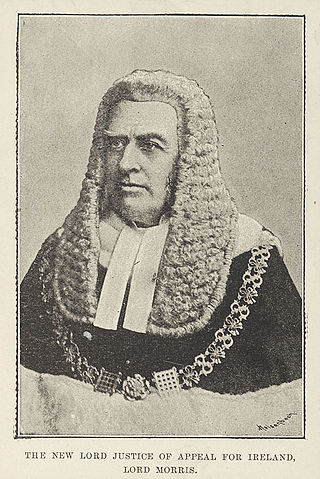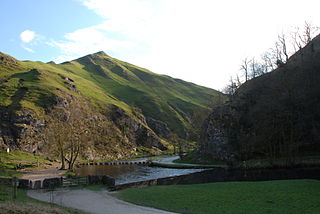
The Attorney-General for Ireland was an Irish and then United Kingdom government office-holder. He was senior in rank to the Solicitor-General for Ireland: both advised the Crown on Irish legal matters. With the establishment of the Irish Free State in 1922, the duties of the Attorney-General and Solicitor-General for Ireland were taken over by the Attorney General of Ireland. The office of Solicitor-General for Ireland was abolished at the same time for reasons of economy. This led to repeated complaints from the first Attorney General of Ireland, Hugh Kennedy, about the "immense volume of work" which he was now forced to deal with single-handedly.

Rowland FitzEustace, 1st Baron Portlester was an Irish peer, statesman and judge. He was one of the dominant political figures in late fifteenth-century Ireland, rivalled in influence probably only by his son-in-law Garret FitzGerald, the "Great" Earl of Kildare.
The Master of the Rolls in Ireland was a senior judicial office in the Irish Chancery under English and British rule, and was equivalent to the Master of the Rolls in the English Chancery. Originally called the Keeper of the Rolls, he was responsible for the safekeeping of the Chancery records such as close rolls and patent rolls. The office was created by letters patent in 1333, the first holder of the office being Edmund de Grimsby. As the Irish bureaucracy expanded, the duties of the Master of the Rolls came to be performed by subordinates and the position became a sinecure which was awarded to political allies of the Dublin Castle administration. In the nineteenth century, it became a senior judicial appointment, ranking second within the Court of Chancery behind the Lord Chancellor of Ireland. The post was abolished by the Courts of Justice Act 1924, passed by the Irish Free State established in 1922.
Nicholas St Lawrence, 4th Baron Howth was a leading Irish nobleman, soldier and statesman of the early Tudor period, who held the office of Lord Chancellor of Ireland.

The Court of Exchequer (Ireland), or the Irish Exchequer of Pleas, was one of the senior courts of common law in Ireland. It was the mirror image of the equivalent court in England. The Court of Exchequer was one of the four royal courts of justice which gave their name to the building in Dublin in which they were located, which is still called the Four Courts, and is in use as a courthouse.
Sir James Dowdall was an Irish judge of the Elizabethan era who briefly held office as Lord Chief Justice of Ireland. He should not be confused with James Dowdall, the Catholic martyr, who was his cousin.
Sir Robert Dowdall was an Irish judge who held the office of Chief Justice of the Irish Common Pleas for more than forty years. He is mainly remembered today for the murderous assault on him by Sir James Keating, the Prior of Kilmainham, in 1462.
John Chevir or Chevyr was an Irish judge and politician of the fifteenth century. He held the offices of Lord Chief Justice of Ireland and Master of the Rolls in Ireland, and was also one of the first recorded Speakers of the Irish House of Commons.
John Payne, Bishop of Meath, held that office from 1483 until his death in 1506; he was also Master of the Rolls in Ireland. He is best remembered for his part in the coronation of Lambert Simnel, the pretender to the Crown of England, in 1487.
Robert Sutton was an Irish judge and Crown official. During a career which lasted almost 60 years he served the English Crown in a variety of offices, notably as Deputy to the Lord Chancellor of Ireland, Chief Baron of the Irish Exchequer, Master of the Rolls in Ireland, and Deputy Treasurer of Ireland. A warrant dated 1423 praised him for his "long and laudable" service to the Crown.

Thomas de Everdon was an English-born cleric and judge, who was a trusted Crown official in Ireland for several decades.
Oliver FitzEustace was an Irish judge. His appointment as Chief Baron of the Irish Exchequer was a surprising one since according to the leading historian of the Irish judiciary he appears to have been unable to speak.
John Estrete, or Strete was an Irish judge, author, law lecturer and statesman of the late fifteenth century. He held the offices of King's Serjeant, Deputy Chief Baron of the Irish Exchequer, and Master of the Coinage of Ireland. He was a member of the Privy Council of Ireland. He wrote at least one legal textbook, Natura Brevium.
John Burnell was an Irish judge who held office as Chief Baron of the Irish Exchequer.

Thomas Dowdall, also spelt Dowdale, Douedall, or Dowedall, was an Irish barrister and judge who held the office of Master of the Rolls in Ireland.
Henry Duffe or Duff was an Irish judge of the late fifteenth century.
The Great Seal of Ireland was the seal used until 1922 by the Dublin Castle administration to authenticate important state documents in Ireland, in the same manner as the Great Seal of the Realm in England. The Great Seal of Ireland was used from at least the 1220s in the Lordship of Ireland and the ensuing Kingdom of Ireland, and remained in use when the island became part of the United Kingdom of Great Britain and Ireland (1801–1922), just as the Great Seal of Scotland remained in use after the Act of Union 1707. After 1922, the single Great Seal of Ireland was superseded by the separate Great Seal of the Irish Free State and Great Seal of Northern Ireland for the respective jurisdictions created by the partition of Ireland.
Sir James Keating was an Irish cleric and statesman of the fifteenth century. He was Prior of the Irish house of the Knights Hospitallers, which was based at Kilmainham, Dublin, and a member of the Privy Council of Ireland.
Walter Champfleur or de Champfleur was an Irish cleric and judge of the fifteenth century, who played a leading role in Irish politics.
William Archbold was a senior official in the household of three Kings of England. He was an Irishman, and later returned to Ireland, where he became a judge. The Archbolds were a Dublin family who had been early Anglo-Norman settlers in Ireland.
 Sketch for a Great Seal of Ireland, designed by Nicholas Hilliard for Queen Elizabeth I
Sketch for a Great Seal of Ireland, designed by Nicholas Hilliard for Queen Elizabeth I 




